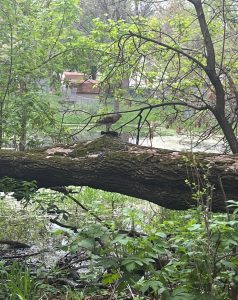Spring is in the air, and junior Louis Fratzke, a longtime bird enthusiast, is excited to get back outside to observe one of his favorite animals.
Fratzke has been interested in birds since the pandemic hit in early 2020. This was partly inspired by his dad’s interest in birds and partly inspired by the animals themselves.
“I had my online learning desk right in front of the window. Right in front of the window was a bird feeder and a water [dispenser],” he said. “And so I saw a bunch of birds going in and out, especially during migration season.”
Fratzke was excited to have the opportunity to learn about birds he never knew about. And this fascination grew as he traveled throughout the Twin Cities to bird-watch alongside his father.
“My dad and I go to various parks around the Twin Cities. There [are] a lot … along the Mississippi River that … are completely free to go in and have a bunch of fields that are a great habitat,” Fratzke said.
His favorite kind of bird above all is ducks–the birds he’s spent the most time observing and learning about. In Minnesota, there are 23 species of ducks and geese in total, such as mallards, wood ducks, Canada geese and snow geese. Fratzke is familiar with nearly all 23.
The rarest duck he’s seen while birding was a bufflehead: a small duck with a large round head. Female buffleheads are typically greyish-brown with a white patch on the side of their heads, while adult males are black and white with shiny iridescent heads and a larger white patch on the back and sides.
“I think it’s just interesting how many different kinds of ducks there are because more people only know the generic green mallards,” Fratzke said.
But he’s not the only one who’s fascinated by the wide variety of creatures that live in nature. Senior Ada LaTarte has found a passion for bugs, and that passion was also partly cultivated by a parent.
“I was first seriously introduced to bugs because my mother was a butterfly scientist,” she said. “I spent a lot of time in her lab as a kid and became very comfortable with bugs.”
LaTarte spent four months at Chewonki, a semester away program on the Maine Coast, in the first semester of the 2023-24 school year. Semester away programs are opportunities for students to spend half of their school year at another location and experience a new learning style or focus on a specific area of interest. With up to 45 students enrolled at a time, Chewonki focuses mainly on stewardship and appreciation for the natural world, as well as sustainability and other environmentally-geared ideas. LaTarte’s love for bugs was also inspired by her experience there.
“My time at Chewonki cultivated a deeper appreciation for bugs, separate from my experiences with my mother,” she said
She was glad to be exposed to so many unique species of bugs and to have the opportunity to observe them at any time.
As leader of the Art in Nature Club, LaTarte has found joy in combining her two passions: creating art and observing and learning about bugs.

“I find now that I usually interact with bugs through my artwork. I think this appreciation for bugs, and more generally nature, has been something that has been with me for most of my life, but it’s definitely evolved,” LaTarte said.
Junior Ethan He shares both LaTarte and Fratzke’s passions. “I think that I’ve always been drawn to both bugs and birds since I was little because of how they’re so different from us. They always seem like a rare occurrence when you see a colorful bird or a large beetle. That’s what I think makes them special,” he said.
He’s appreciation for bugs stems from the ability to go out and observe.
“You can just flip a rock and find multiple species of bugs living under there,” He said.
As an outdoor-creature enthusiast, He is gearing up for another season of bird-watching and bug observation, and as spring begins, more and more opportunities arise.